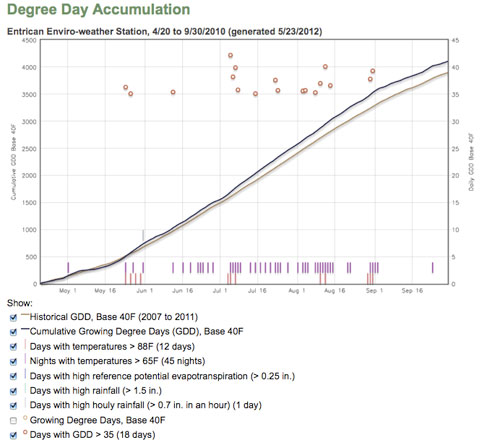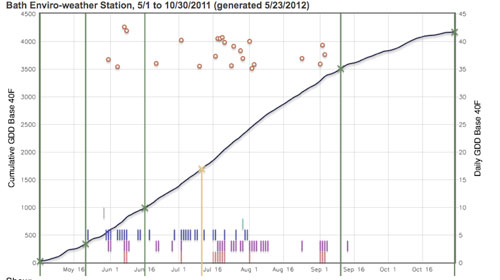New potato maturity and stress graphic tool available on Enviro-weather
The MSU Enviro-weather Potato Maturity and Stress Graph tool will help potato growers evaluate and mitigate crop stress caused by weather and other factors.
Stress events, such as excessive heat, drought, or even physical damage from herbicides or hail, can affect the quality of a potato crop, especially if they occur during critical growth stages. For example, excessive heat can reduce tuber quality and increase internal defects. Did you know that Enviro-weather has a new graphical tool that can document timing of various stress events relative to potato growth and help you plan for optimal storage of your crop?
The new “Enviro-weather Potato Maturity and Stress Graph” displays cumulative growing degree days (base 40°F) over the season. The graph also includes degree days forecasted for the next seven days. The timing of potentially stressful weather events,such as daytime temperatures above 88°F, nighttime minimum temperature above 65°F,rainfall over 1.5 inches or a rate of more than 7/10 of an inch per hour, are shown on the graph with special symbols. There is also an option to display “historical”growing degree days (base 40°F) for that location to help you compare the current season to what is “normal” (see Figure 1).
Figure 1. Enviro-weather Potato Maturity and Stress Graph cumulative growing degree days displayed

The graph can be made even more useful by customizing it with conditions and events specific to your location and field. To do this, first create an account on Enviro-weather, specify your “field locations” and chose the weather stations you wish to draw data from. You can then add information specific to your field. For example, you can list the date of key crop events (planting, emergence, flowering, tuber initiation, vinekill, harvest, etc.) and other stress events (herbicide injury, hail,defoliation, etc.). You can also customize the definition of these events. For instance, you can choose a higher temperature for a nighttime heat event or a different base temperature for cumulative growing degree-days. Enviro-weather will display a graph for each field with the generic information described above, plus the additional customized information you supply (see Figure 2).
Figure 2. Enviro-weather Potato Maturity and Stress Graph customized with information you supply
Setting up an Enviro-weather account allows you to save the specific information you enter. Then, each time you log in the details of your individual fields are displayed, along with any settings you have chosen.
This new tool can help potato growers evaluate the stress their crop has experienced and the timing (relative to critical growth stages) of these stress events. For example, we know that potatoes are most susceptible to environmental stress during tuber initiation and bulking. If the Enviro-weather Potato Maturity and Stress Graph indicates that stressful weather events have occurred or will occur during these times, growers can minimize effects by, just say, maintaining soil at field capacity with irrigation. The graph’s seven-day forecast feature allows growers to consider using liquid calcium nitrate or calcium sulfate applications to the foliage prior to stress events. Growers can also delay practices that could potentially add to the stress, such as high nitrogen applications.
The Enviro-weather Potato Maturity and Stress Graph can also help growers decide if their crop is at risk for physiological defects and choose the best marketing and storage options for each field. Growers can schedule potatoes that were produced under the least stressful environment for longer-term storage. Similarly,growers can market potatoes that experienced the greatest amount of environmental stress as soon as possible (either out of the field or from short term storage).
If you have any questions or comments about this new tool, or any other Enviro-weather feature, please contact Beth Bishop, Enviro-weather coordinator, at517-432-6520.
Many thanks go to the Michigan Potato Industry Commission (MPIC) and MSU potato specialist Chris Long for their help conceiving of and developing this new tool. This work was funded by the MPIC and a MDARD Specialty Crop Grant.
Additional information
- MSU Extension’s Drought Resources



 Print
Print Email
Email



